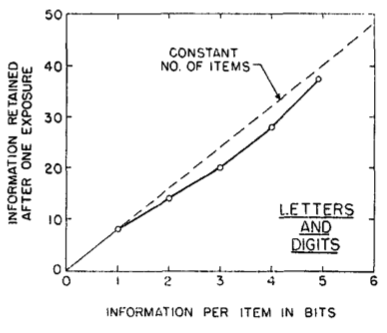Andyʼs working notes
About these notesHuman channel capacity increases with bits-per-chunk
One common workaround for Channel capacity of humans as information processors appears to be making a sequence of smaller observations, rather than a single complex absolute judgment. This only works if you can hold the sequence in your head, so it’s limited by your Span of working memory. Happily, Working memory span is mostly independent of item complexity. So you can increase your effective channel capacity by increasing the number of bits in each observed chunk (“Chunks” in human cognition).
In this figure depicting data from Pollack (1953), channel capacity expands almost linearly with bits-per-chunk (Miller, 1956, p. 92).
This effect is still limited by the Span of absolute judgment, so to expand bits-per-chunk beyond 5, you’ll need to make chunks multidimensional (Human channel capacity increases with stimulus dimensionality).
Q. How does human channel capacity vary for a sequence of elements, as the number of bits transmitted in each element increases?
A. It increases roughly linearly.
Q. Why does it matter that the span of working memory is roughly independent of the span of absolute judgment?
A. It suggests that we can hold more information in working memory by increasing the “chunk” size of the items held in memory.
References
Miller, G. A. (1956). The magical number seven, plus or minus two: Some limits on our capacity for processing information. Psychological Review, 63(2), 81–97. https://doi.org/10.1037/h0043158 Miller - The magical number seven, plus or minus two
Pollack, I. (1953). Assimilation of Sequentially Encoded Information. The American Journal of Psychology, 66(3), 421–435. JSTOR. https://doi.org/10.2307/1418237